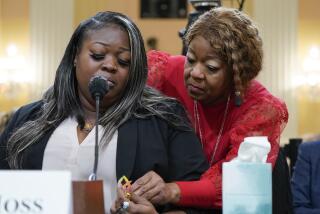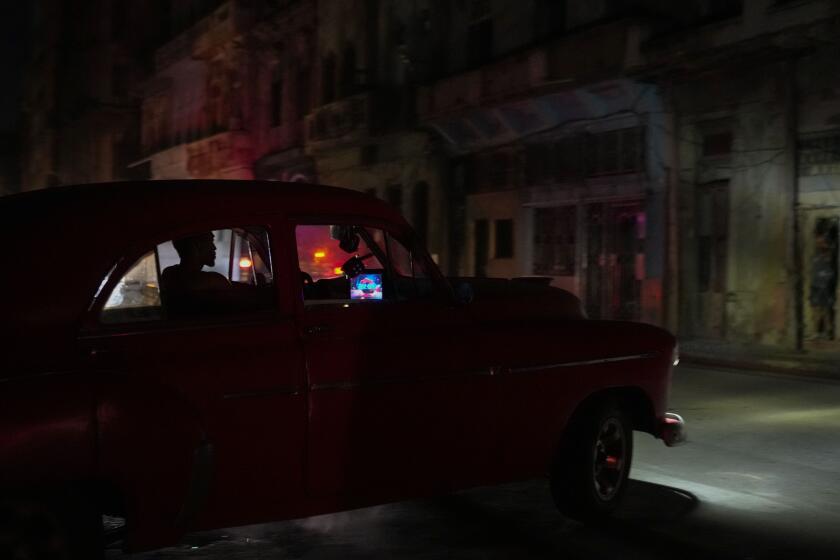Making Each Day Count
The first sign that something was wrong came during Labor Day weekend 1993.
David Norwood and his wife, Petra Perez, were in the Sierra on the third day of a backpacking trip when his left leg began to tire.
He thought little of it. “I thought that I pulled a muscle or something,” Norwood said.
But during the following months, the Thousand Oaks resident developed a limp in that leg. Then a twitch. And he began to stumble.
Norwood went to see a doctor, then more doctors. And when his visits and tests were over, the news wasn’t good.
Norwood, just 30 years old at the time, had Lou Gehrig’s disease.
“It was depression at that point,” he said, his voice weak as he struggled to speak several words at a time. “He said I had two to five years. I spent a lot of time crying.”
Lou Gehrig’s disease, formally known as amyotrophic lateral sclerosis, or ALS, is a progressive neuro-degenerative disease that attacks nerve cells in the brain and the spinal cord.
It first paralyzes, then kills half of those who have it within five years, experts say.
But it’s been more than six years since Norwood’s diagnosis, and he is showing no signs of dying. His tears have diminished, and Norwood, who can now move only his head and two fingers on his right hand, is content with his life.
Since his diagnosis, Norwood has climbed Mt. Whitney and fathered two children. While his financial stability helps him get the medical care he needs, those who know him best point to his will to live and strong spirit as reasons the former Amgen employee is still going strong.
“I marvel every day,” said his sister, Naomi Norwood, 46, an attorney in Topanga Canyon. “I am in utter awe of him. Being around him changes the way you view the world. It changes the way you view everything. You sure have a lot less tolerance for people who don’t appreciate their lives.”
There is no cure for Lou Gehrig’s disease, named for the Hall of Fame baseball player who lost his life to the illness in 1941. As the disease progresses, the brain loses the ability to initiate and control muscle movement. Patients in the disease’s later stages become totally paralyzed, according to the ALS Assn., although the minds of most remain unaffected.
As many as 40,000 people across the country are living with ALS, said Dr. Linda Boynton De Sepulveda, executive director of the UCLA MDA/ALS Clinic and Research Center in Los Angeles. Years ago, the disease often didn’t appear until people were 55 to 60 years old, but more and more cases are manifesting themselves earlier, she said. For 90% of ALS patients--including Norwood--doctors are unable to determine the cause. The other 10% have inherited it, Boynton De Sepulveda said.
At least 800 people are living with ALS in Ventura, Los Angeles and San Bernardino counties, said Debi Klein, executive director of the ALS Assn.’s Greater Los Angeles Chapter. While Klein has seen some people live for more than 10 years, most ALS patients she’s seen have died within two.
“You know you’re going to die,” Klein said. “You know you’re not going to be able to see your children grow up and your family develop. And with projects you started, you know you’re not going to be able to see them through. There are certainly a lot of issues.”
Days After Diagnosis, a Monumental Hike
In one final hurrah just days after his diagnosis, Norwood and Perez hiked to the top of Mt. Whitney, a 14,495-foot peak in the Sierra Nevada and the tallest in California.
“I figured it was my last chance to do it,” Norwood said.
There would be last chances to do other things, too. In 1997, Norwood needed crutches to walk. The next year, he needed a wheelchair. Months later, his arms gave out and he needed a power wheelchair. And by the end of 1998, Norwood couldn’t breathe well and it was getting more difficult to eat.
By that time, Perez was bathing, dressing and feeding him. Full-time nurses now perform those tasks daily, with Perez filling in at night. It now takes as long as 2 1/2 hours each morning to get Norwood ready for his day.
“Every time my disease progressed, it took adaptation,” he said. “It was always tough. I might go for six months and not progress a lot, and then whenever I lost the ability to do something, it was tough. It was depressing.”
It became even more difficult for Norwood when he couldn’t bond with his oldest son as much.
“I used to be able to hold him and tickle him,” Norwood said of Justin, now 5 1/2. “But I don’t think he has any memory of me not in a wheelchair. He was only a couple of years old then.”
By early 1999, Norwood had lost the ability to do almost everything. That April, Norwood left Amgen on disability. He had worked with the company since 1995, most recently as a computer operations manager.
Before he left, but after his arms gave out, Norwood relied upon Perez to drive him to work, and he’d use a voice recognition system to operate his computer.
“I knew a lot more people that would call in sick who never had a bad illness, and he’d never call in sick,” said Yanira Vasquez, who worked under Norwood at Amgen. “He never allowed his illness to stop him from coming to work.”
Leaving work was difficult for Norwood, because it made him feel unproductive, he said.
Through it all, though, Perez--who gave up designing retail stores from home two years ago when Norwood needed more care--was there.
Family and friends marvel at her resilience.
“Just watching Petra and David is such an inspiration now,” said Norwood’s mother, Virginia. “They’re so cheery about it.”
Perez, who met Norwood in 1984 while both were undergraduates at Cal Poly San Luis Obispo, said she would pray for the strength to keep going after her husband was diagnosed. But throughout his ailment, she’s never left his side, and she keeps a smile on her face.
“Crying doesn’t help matters any, so I try to concentrate my efforts on what does,” she said. “I concentrated on making our life better, my pregnancy, and tried to make our life normal. . . . Nobody says it’s easy.”
Judy Datria of Torrance knows firsthand how hard it is on a spouse.
“I wouldn’t wish this on my worst enemy,” said Datria, a friend of the Norwood family whose husband, James, died at 68 of ALS. “It’s a horrible disease to see someone deteriorate daily and dwindle down to nothing. And you feel helpless. You can’t help them in any way.”
Norwood hit his low point by mid-1999. Unable to breathe well, nearly unable to eat, the 5-foot-7-inch Norwood dropped from about 150 pounds to 110, he said.
Surgical Procedure Was Family Decision
Then came a decision that changed everything.
After consulting with doctors and his family, Norwood decided to have a tracheostomy, a surgical construction of a respiratory opening in the trachea. The procedure would leave Norwood tethered to a ventilator, but able to live more comfortably.
The operation isn’t cheap, nor is the aftercare. For patients in advanced stages of ALS like Norwood, that care can cost as much as $150,000 a year.
But Norwood, who is covered by long-term disability from Amgen, could afford it. He’s also still covered by insurance. When it is no longer available, Perez probably will return to work.
Since the mid-1999 operation, Norwood has been able to breathe, speak and eat much more easily. He’s also gained at least 25 pounds and a renewed lust for life.
Boynton De Sepulveda, who has seen Norwood at her clinic, said tracheostomy patients are at risk because the operation increases the chance of infections. But by breathing more easily, ALS patients with ventilators can live up to 15 to 20 years longer, she said.
That was the selling point for Norwood. And it was enough to convince him and Perez to move forward with something they’d been planning since their 1989 marriage: having a second child.
Kevin was born in June.
“It was a very happy time,” he said. “At that point we were very positive about living with ALS for as long as I can.”
Norwood doesn’t think about dying. Instead, he does everything he can to embrace life. He attends movies with friends. He visits zoos and aquariums with his family. And he uses his eyebrows to activate a switch taped to his forehead to use his computer. Through it, he e-mails acquaintances and is able to control the television, stereo, thermostat and lighting in his home.
“He is a shining example of what can be done with your life,” said Jeani Dodd, Norwood’s next-door neighbor. “I just know I would crumble, and it makes my admiration for him so much more.”
Now Norwood just takes it all in. He watches Justin play with the new friends he’s made at Ladera Elementary School. He watches Perez feed Kevin and tuck him into his crib. And on cool days, he sits outside and stares at the things he often ignored: the green grass, the blue skies and the mammoth trees that some birds and squirrels call their home.
There are also the moments when he envisions himself back on his feet.
“I dream sometimes that I’m walking,” Norwood said. “It’s great. I would wake up and just for a couple of seconds forget. I’d just think, ‘OK, I’m just going to get up and start walking.’ It’s nice to forget for a while.”
It’s already difficult for Norwood to speak for long periods. There will come a day when he can no longer communicate without a computer. But Norwood is keeping his eyes on the good things ahead.
Topping that list is watching his children grow.
“They definitely give me a reason to live,” he said. . . . “Probably the thing I think about most is seeing them graduate college. That’s the goal.”
Norwood and Perez are doing their best to stay strong. And so far, they’re succeeding. With the ventilator came a new lease on life.
Norwood just watched Kevin celebrate his first Christmas, and he was looking forward to having friends over for New Year’s Eve.
When he first was placed in a wheelchair, Norwood worried about how people viewed him. He wondered if they pitied him.
But not anymore.
“I feel like I’m in a lot better situation than a lot of people,” he said. “A lot of people don’t have the family support that I have. If somebody sees me and automatically just feels pity for me, they don’t understand my life at all. I’m not that person that they feel sorry for. I think I have a pretty good life.”
More to Read
Sign up for Essential California
The most important California stories and recommendations in your inbox every morning.
You may occasionally receive promotional content from the Los Angeles Times.










